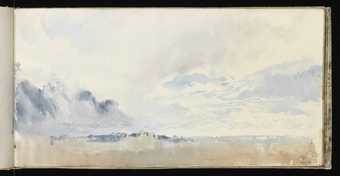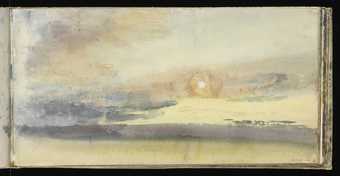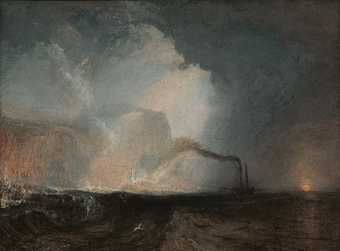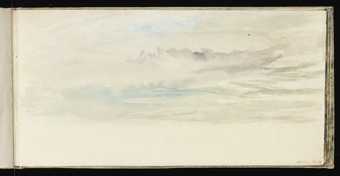
Study from J.M.W. Turner’s Skies Sketchbook, 1816–18, watercolour on paper, 12.5 x 24.7 cm
Courtesy Tate Archive
Londoners can be starved of sky; they glimpse fragments between blocks of flats or in a busy street. They develop a greedy appetite for the luxury of an open sky which stretches in all directions. This was the starting point for my Hebridean journeys, which over the course of six years explored islands from the mouth of the Clyde out to the furthest, most westerly point in the British Isles, St Kilda, 40 miles west of Lewis.
The Hebridean archipelago lies on the frontier where the European continent finally meets the edge of the Atlantic Ocean. The sense of space, of land and sea is palpable, and overhead stretches a sky that is never the same two days in a row. Weather systems roll in from the Atlantic, often carried by gales which have gathered enormous fetch as they sweep across thousands of miles of ocean. In winter, one day out of five, the winds can reach gale force.
Much of the experience of this islandscape is about scale – both oceanic and continental – which is unfamiliar in the intricately worked and densely populated landscapes of Britain. The land plays a modest role in these spaces of air and water. Even the drama of the Cuillins of Rum or Skye are dwarfed by the surrounding seas and skies. More often, the islands of the Hebrides are low lying, such as South Uist, where the distinctive machair (a Gaelic word meaning an extensive fertile plain) of the coastline stretches along the empty white beaches beyond the eye’s vision. Perched here on the dunes, facing out to sea to watch the clouds arrive, it feels as if one is strapped to the prow of a ship, such is the breadth and height of sky.
That expanse of sky is a fast-changing drama of cloud and rain. It’s a place of constant surprises. One’s eye is drawn repeatedly – sometimes anxiously – to the horizon to forecast the weather; the piling up of grey cloud which presages rain, or the sudden gleam of sun streaming through to silver a patch of sea. Sometimes a day of heavy rain eased in the evening, and over to the west a sunset of deep red and golds illuminated the horizon, making entirely plausible those magical lost islands which have been so central to the mythology of the Atlantic.

Study from J.M.W. Turner’s Skies Sketchbook, 1816–18, watercolour on paper, 12.5 x 24.7 cm
Courtesy Tate Archive
When the rain clouds broke up and splashes of blue sky appeared, rainbows were commonplace, not one but often several, sprinkled across the land, glittering with brilliant colour against the sombre moor and steel grey seas. I saw for the first time, over Jura, an unbroken semi-circle, every strand of colour sharply distinct.
Of course on other days the sky – and the ocean – disappeared entirely into the wet grey of thick smirr (Scottish for a fine rain or drizzle), which hung low over the land. The sensation was of being wrapped in damp felt; sound was muffled, vision suddenly restricted to a few feet. It felt as if the islands had been swallowed whole by clammy clouds of water vapour.
Sometimes that very water vapour lent a luminescence to the light so that far-distant islands gleamed with uncanny clarity. I sat on Staffa’s cliffs on such a day. The nearby Treshnish Isles were scattered on the horizon, and around me lay Staffa’s undulating plateau swept clear of all shrubs by its exposure to the gales. Such was the sense of exhilaration that it was as if I were on a platter flying low over the sea.
J.M.W. Turner made the journey to Staffa in 1831. It had become a landmark for a generation of Enlightenment thinkers and Romantics because of the famous hexagonal basalt columns which line Fingal’s Cave. In their letters home from their visits to Staffa, Keats and Mendelssohn wrote with enthusiasm of the marvels of the cave and the sound of the waves thundering down the channel between the columns. In 1832, within a few weeks of each other, Turner’s painting Staffa, Fingal’s Cave was unveiled and Mendelssohn’s Hebrides Overture premiered, putting the Hebridean island of Staffa centre stage in the cultural life of Britain.

J.M.W. Turner, Staffa, Fingal’s Cave 1831–2, oil on canvas, 90.8 x 121.3 cm
Courtesy Yale Center for British Art, Paul Mellon Collection
But Turner was more interested in the sky than the cave. In his painting, three quarters of the canvas is taken up by the sky, while the famous cave almost disappears amid the cloud. It is the sky of a dramatic Hebridean storm with its wild clouds and strange shafts of light. It serves to dwarf the picture’s centrepiece, that great miracle of Victorian engineering, the steamship.
On his visit, terrible weather had intimidated the passengers, who refused to continue their trip to Iona; the boat circled Staffa as it headed back to port, and Turner – who had a great admiration for poetry as the sister art of painting – later wrote that ‘the sun getting towards the horizon burst through the rain cloud, angry, and for wind’.
As I continued north from Staffa to Rum, and then over the Minch to Barra, and on to Lewis, Turner’s awkward but apt comment on the angry sun ‘for wind’ stayed with me. It was a reminder that visitors to this coastline find themselves often in the midst of an enormous argument in the skies overhead, a boisterous encounter of land and ocean, and of the elements of air, water and light.

